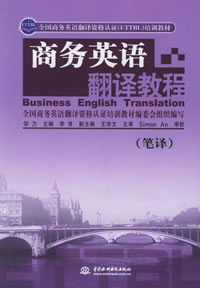职业翻译与有效的知识转化 (I)
作者:古龙 2009-07-04




语际翻译公司 转载请注明https://www.scientrans.com
∗本栏目部分文章内容来自互联网,部分已经过本站编辑和整理,如有版权事宜请联系Email/MSN jesczhao@hotmail.com
c. Writing is different for everyone—it varies from one person to the next. This is because people are different, their thinking processes and learning styles vary. A person writes to fit his or her personality and thinking style.
11. A good translator must be aware of the importance of cognitive information processing of texts so that they can be accurately understood, processed and transformed by their cognitive system.
12. Based on the researcher's experience as a translator, on her discussions with other translators, and on this research, the researcher strongly feels that the above writing processes and the three features of writing put forward by Smith-Worthington and Jefferson (2005) can be extended to the process of translation. Here too we see a close parallelism between writing and translating because they share similar features and approaches.
b. The Process of Translation
A competent translator must be aware of the process of translation to make effective knowledge transfer from one language to another possible. From the feedback obtained from the five participants who took part in the think-aloud protocols and interviews, the researcher discovered that the main direct and indirect strategies proposed by Oxford (1990) were used by them while translating. These strategies are shown in Table 1 on the next page. From the TAPs analysis using the inductive method, the researcher matched her analysis of the TAPs transcriptions to Oxford's (1990) Strategy Inventory for Language Learning (SILL) and found three additional strategies used by the participants which were not present in Oxford's SILL. The new findings comprise one metacognitive and two cognitive strategies. The three new strategies comprise the following:
1. Stating one's own beliefs on how to translate and giving the reasons supporting them (metacognitive strategy).
From this research, it was apparent that the participants had their own mindset or schema about how to go about translating. They verbalized aloud this preconception or design of the expected completed version or virtual blueprint of their translated product. While translating they reminded themselves that they should abide by these beliefs which were arrived at from past experience and translation training. Some examples include:
a. "Now that I know the meaning in my head, I shall translate it using my own words in Malay so that the original meaning is not lost. I do not believe in and do not practice word-for-word translation. I prefer understanding first before translating," and
b. "I don't translate word-for-word. Being a Malay, I have language intuitiveness and upon further reading, I always refine my translated work."
Table 1
OXFORD'S STRATEGY INVENTORY FOR LANGUAGE LEARNING (SILL)
DIRECT STRATEGIES
1. Memory Strategies
a. Creating mental linkages
(e.g. grouping, associating, elaborating)
b. Applying images and sounds
(e.g. using imagery, semantic mapping)
c. Reviewing thoroughly (structured reviewing)
d. Employing action
(e.g. using physical response or sensation)
2. Cognitive Strategies
a. Practicing (repeating, formally practicing with sounds and writing systems, recognising and using formulas and patterns, recombining and practicing naturalistically.
b. Receiving and sending messages
(getting the idea quickly, using resources for receiving and sending messages.)
c. Analysing and reasoning (reasoning deductively, analysing expressions, analysing contrastively (across languages), translating, transferring)
d. Creating structure for input and output (taking notes, summarising, highlighting)
&nb
- 评论
- seme:文章内容文章内容文章内容文章内容文章内容文章内容文章内容文章内容文章内容 章内容文章内容文章内容文章内容文章内容
- seme:文章内容文章内容文章内容文章内容文章内容文章内容文章内容文章内容文章内容 章内容文章内容文章内容文章内容文章内容

- 谈翻译观念的嬗变与翻译技能的训练
2009-6-15 15:33:10 - 《高等学校英语专业英语教学大纲》中规定,大学生通过四年的在校学习,“能运用翻译的理论和技巧,将英美报刊上的文章以及文学原著译成汉语,或将我国报刊、杂志上的文章和一般文学作品译成英语……。译文要求忠实...
- 翻译与网络营销
2009-6-11 0:02:31 - Translation and Your International E-Commerce Strategy Most businesses realize that they ...
- 第四届IEEE生物信息与生…
2009-6-30 19:42:01 - 基本信息 主办单位: 四川大学,IEEE生物医学工程协会(EMBS) 承办单位 开始日期 2010/06/18 结束日期 截稿日期 2009/1...
- 第九届全国光电技术学术…
2009-6-30 19:35:58 - 基本信息主办单位: 中国宇航学会光电技术专业委员会承办单位 开始日期 2009/11/01结束日期 截稿日期 2009...
















